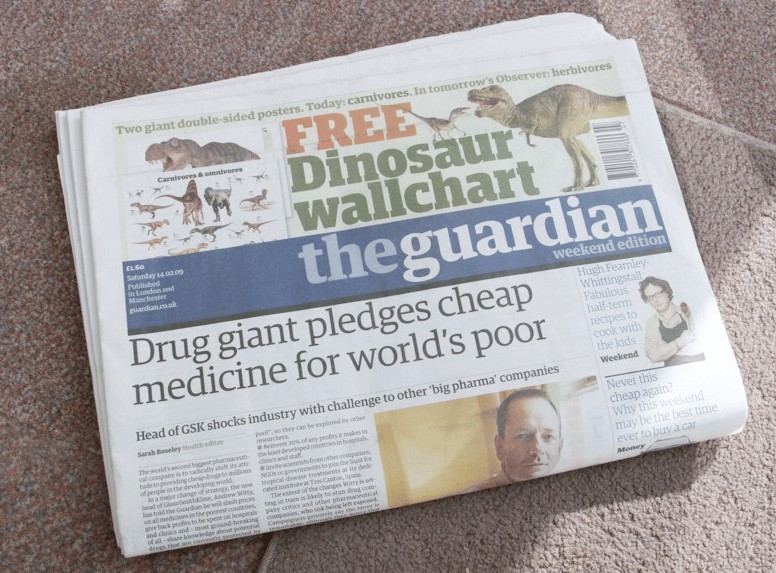
Depending on whom you choose to believe this month, The Guardian will either cease its print edition, make it free, should start charging online or must lobby for proceeds from an ISP tax.
None of those things is actually happening – but the competing chatter illuminates uncertainty and contrary prescriptions for funding the future of digital news. Here’s what outsiders say, and what’s really going on…
1. Stop the press? Not yet
On Wednesday, a little-known blog called More About Advertising ran an unattributed report that said: “For the first time, canning the print edition and switching to a completely digital product is now being seriously discussed at the top levels of Guardian News & Media” (GNM). It didn’t take much for profitable The Telegraph, which appears to relish attempts to destabilise GNM’s business, to re-air the gossip as a news story. Rattled, GNM leaped on to the front foot, giving paidContent this statement (excerpted), which it issued widely and emailed to its staff:
“There is no truth in reports that The Guardian intends to stop printing newspapers. Our newspapers generate three-quarters of our revenue and will remain the foundations of our organisation for many years to come.”
GNM bought its current print plant in 2005 for around £80 million, stating at the time it would likely be its last. Asked in 2010 to bet when The Guardian would no longer exist in print, Rusbriger said: “I was thinking 20 years at that point (in 2005). I think that might be telescoping quite dramatically now.” In other words, the forecast of going digital-only has been brought forward from 2025.
Numbers for going digital only & junking print just don’t add up. So Telegraph has written the opposite of the truth.
— alan rusbridger (@arusbridger) October 17, 2012
But to suggest that date has moved forward to the near term is more than a little far-fetched. There’s no question that everyone is on a trajectory to a life after print. Last year, GNM began downsizing its newspaper when it rendered itself “digital-first”. But timing is everything. Although abandoning print would strip out significant costs, it would also deprive most publishers of the bulk of their income. For many, that makes little sense; so evolution is the order of the day.
2. No cover price? Could work, won’t happen
This week, industry folk, including those at The Guardian, admired news that the London Evening Standard has turned a £30 million annual loss in to a profit by making its print edition free in 2009. That caused some to wonder whether other papers shouldn’t follow suit…
And the Guardian print edition goes free in 3…2…1… guardian.co.uk/media/greensla…
— James Seddon (@jamesseddon) October 16, 2012
The Standard‘s prescription is clear – even after giving up circulation revenue, it is making more money because advertisers love reaching the wider audience the paper has given them.
Some are now expecting the Standard‘s stablemate, The Independent, to repeat the tactic. The Guardian, whose print circulation is shrinking toward merely the 200,000 mark, would likely make a bigger success of the tactic than The Indy, since, even with that number, it would start with a larger following.
Such a move, ironically, would mimic The Guardian‘s affection for the online free model – on the offline pavements of British cities. If The Guardian’s circulation is diminishing to a point at which paper is simply irrelevant commercially, it could press the “digital-only” button to save money (denied, above) – or it could go for extra-large print circulation by going free, just as The Standard has done. Success however, would rely on consumer appetite for its “quality” journalism amongst an audience of time-starved young commuters.
But don’t expect such a move. A GNM spokesperson tells paidContent: “There are no plans to do that at all. We sell a premium product with appropriate pricing. We are also a national, not restricted to a single city. It’s difficult to see how the free model would work.”
3. Online charges? Not in sight
Everyone knows that, whilst The Guardian charges mobile and tablet subscriptions, it really favours free and “open” web journalism. You only have to look at some onlookers’ view to see the popular commitment to this cause:
Unfortunately @robertandrews paywalls are NEVER going to work – you can’t put the toothpaste back in the tube.
— Jamie Gavin (@jaygavin) October 16, 2012
But not everyone is committed outright; even in The Guardian‘s own circle, some concerned folk think the time is urgent for harder-nosed alternatives to keep the patient healthy. Former Guardian media reporter James Robinson is quoted in the London Evening Standard as saying: “People will pay for quality content despite what Alan Rusbridger says.”
Robinson later clarified that he was just jesting to suggest people should buy his recently-published novella about a phone hacker. But, in a separate Twitter conversation, Robinson this week wondered whether The Guardian should have already introduced web charges, saying: “I always argued for charging while trying to be open minded. Made me unpopular.” GNM’s spokesperson tells paidContent:
“There are no plans but we’ve always said that we aren’t fundamentalists on paywalls. We don’t see the need for them (or the long-term viability of them) right now, but that doesn’t mean that will always be the case.
“Paywalls are not the ‘silver bullet’ for the issues our industry faces. Even papers with a lot of readers inside their paywall are not finding that they are generating enough revenue to maintain them without print revenue.”
What is happening…
Guardian News & Media’s latest annual operating loss grew 42 percent from £33.1 million to £44.2 million ($69 million) thanks to the costs of digital investment and of ongoing staff cutbacks. Digital revenue, a significant part of which is dating classifieds, grew 16.3 percent to £45.7 million.
 The publisher is looking in other nooks for revenue, like professional networks and journalism training. The company is currently trying to make redundant 70 to 100 editorial staff in the latest round of cutbacks.
The publisher is looking in other nooks for revenue, like professional networks and journalism training. The company is currently trying to make redundant 70 to 100 editorial staff in the latest round of cutbacks.
The “digital-first” move of mid-2011 meant GNM would, over next five years, reallocate to digital areas a £25 ($40.24) million investment that was earmarked for print, resulting in a shrinkage of its printed newspaper away from breaking news and to more analysis. Reducing that dead-tree cost base is a priority. Last summer, Guardian Media Group CEO Andrew Miller told me: “All newspapers will ultimately exit print. But we’re putting no timeframe on that. This is about repositioning the business.” Many supplements have been killed.
In their place, much stock has been set in GNM’s latest mission to grow its US digital audience, the strategy behind which is to drive up free eyeball counts and court advertisers in the world’s biggest market.
The publisher this week hired a first ever digital strategy director who seems tasked with a harder-edge search for digital viability, not just digital popularity.
The paper’s proprietor, The Scott Trust, will, at some point in the future, sell its stakes in two B2B assets, Trader Media Group and Top Right Media, for windfalls that can tide it over while it continues seeking a large-scale digital business success of its own
For that reason, the publisher has time in this game. In fact, Robinson reckons: “(The) Scott Trust has enough cash for a decade.” It may not feel like it right now – not least to those facing the axe from their jobs – but, in this regard, GNM is relatively blessed.
GNM’s Wednesday statement continued: “The management and executive of The Guardian and The Scott Trust Ltd have put in place a strategy that has enabled The Guardian to maintain its revenues and grow its audience to record levels.” A separate statement, rushed out in response to the articles about its print future, heralded its online reader count as a marker of its reach, if not its business success.
As that strategy – “digital first” and a smaller print edition – plays out, the publisher is aware that it doesn’t have all the answers. And it should expect that proponents of models on all sides think they have a better idea.
Disclosure: Guardian News & Media is an investor in paidContent’s publisher, Giga Omni Media.